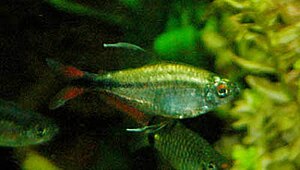South American thread tetra
| South American thread tetra | ||||||||||||
|---|---|---|---|---|---|---|---|---|---|---|---|---|

South American thread tetra ( Hemigrammus filamentosus ), male |
||||||||||||
| Systematics | ||||||||||||
|
||||||||||||
| Scientific name | ||||||||||||
| Hemigrammus filamentosus | ||||||||||||
| Zarske , 2011 |
The South American thread tetra ( Hemigrammus filamentosus ) is a small freshwater fish that occurs in the catchment area of the Rio Araguaia in Brazil.
features
The species becomes about 4 cm long and is elongated, slightly high back (body height 32 to 41% of the SL ) and laterally strongly flattened. The fish are brownish-gray in color, with the scales on the upper half of the body having dark edges, creating a net pattern. The belly is silvery white. The upper half of the iris is reddish. In the middle of the body begins a longitudinal band that is initially bluish and narrow and becomes blacker and wider towards the tail. The South American thread tetra shows a pronounced sexual dimorphism , in the males the first rays of the dorsal, anal and pelvic fins are elongated like threads, which is indicated by both the German and the scientific name ("filum" = Latin for thread). The ends of these fin rays are colored white. In addition, the base of the upper and lower lobes of the caudal fin is reddish in males. The remaining fins are smoky gray. However, a real tail-root spot , as in the similar species Hemigrammus taphorni , is missing. Further differences to H. taphorni are the lack of a shoulder spot and more scales in a central longitudinal row (32 to 35 vs. 30 to 32). In front of the dorsal fin there are 9 to 10.5 scales, around the caudal stalk there are 12 (14 in H. taphorni ).
In addition to the normal coloration, there is also a pathological gold form, which arises from the fact that the fish are attacked by larvae of certain flukes (Trematoda) and encapsulate them with guanine excretions, which gives the fish a monochrome golden or silvery color. Only the color of the dorsal, anal and pelvic fins corresponds to the normal shape and the longitudinal ligament is only visible on the tail stalk and shortly before.
On the upper branch of the first gill arch there are 6 to 7 gill spines , on the lower 13 to 14, so that a total of 19 to 21 gill spines are present. The fish have 32 to 33 vertebrae.
literature
- Axel Zarske: Hemigrammus filamentosus spec. nov. - the South American thread tetra, a new tetra (Teleostei: Characiformes: Characidae) from the Araguaya Basin in Brazil Vertebrate Zoology, 61 (1) 2011, 3–12
Web links
- South American thread tetra on Fishbase.org (English)